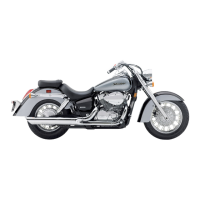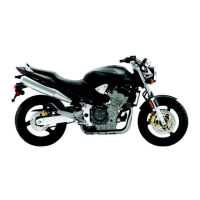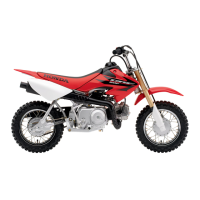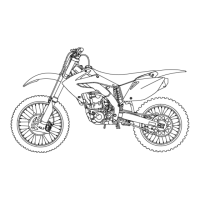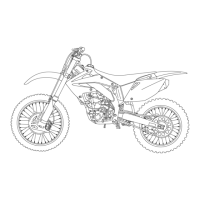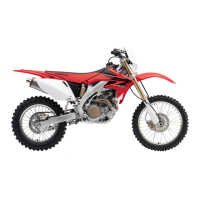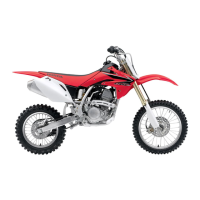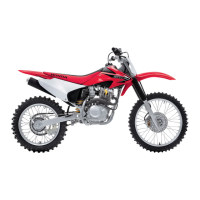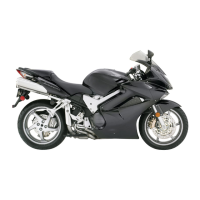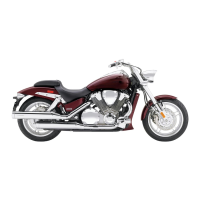Do you have a question about the Honda 450X 2005 and is the answer not in the manual?
Essential safety information and recommendations for riding your CRF safely.
Guide to the location and function of the motorcycle's basic controls.
Pre-ride checks and preparation to ensure you and your CRF are ready.
Fundamental procedures for operating the CRF, including starting, stopping, and shifting.
Explanation of why regular maintenance is crucial for safety and performance.
Critical safety precautions to follow before and during maintenance tasks.
Periodic service intervals for regular off-road and competition use.
Specific maintenance tasks and recommendations for competition use.
Visual identification of parts relevant to servicing and maintenance procedures.
Guidance on recommended unleaded fuel types and octane ratings for the CRF.
Safe steps for refueling the motorcycle, including fuel cap and tank capacity.
Procedures for servicing the fuel filter to ensure proper fuel flow to the carburetor.
Recommended engine oil types and viscosities for the CRF.
Steps to check and add engine oil to maintain the correct level.
Detailed procedure for changing engine oil and oil filter.
Recommended transmission oil types and viscosities for the CRF.
Step-by-step guide for draining and refilling the transmission oil.
Recommended coolant types and mixture for the CRF's liquid cooling system.
Checks for leaks, hose condition, and radiator integrity.
Procedures for replacing coolant, emphasizing safety precautions.
Steps to remove air from the cooling system after coolant service.
Instructions for cleaning and servicing the air cleaner element for optimal engine performance.
How to inspect and adjust throttle lever freeplay for optimal control.
Checks for proper throttle assembly positioning and cable condition.
How to inspect and adjust clutch lever freeplay for proper operation.
Procedures for checking smooth clutch lever operation and cable condition.
Inspecting clutch discs and plates for wear and damage.
Procedure for inspecting clutch springs for free length and condition.
Steps for correctly installing clutch discs, plates, and related components.
How to inspect and adjust freeplay for the hot start lever.
Recommended spark plug types and heat range for optimal engine performance.
Detailed steps for replacing and inspecting the spark plug.
Checking exhaust system mounting bolts and for cracks or deformation.
Steps for removing the muffler for inspection or replacement.
Procedures for installing the muffler correctly and to specified torque.
Procedures for installing the exhaust pipe and tightening nuts to specification.
Procedure for servicing the spark arrester to maintain efficiency and comply with regulations.
Steps for removing the cylinder head cover to access valve train components.
Method for positioning the piston at TDC for accurate valve clearance measurement.
How to inspect both valve clearance and decompressor arm clearance.
Steps for removing the camshaft holder assembly for valve clearance adjustment.
Procedure for selecting and measuring shims for valve clearance adjustment.
Steps for installing the camshaft holder assembly after adjustment.
Procedure for adjusting the decompressor arm clearance for proper engine operation.
Procedures for installing the cylinder head cover and associated components.
Steps for removing the cylinder head for engine disassembly.
Procedures for removing the cylinder from the engine.
Steps for removing the piston from the cylinder.
Procedures for correctly installing piston rings onto the piston.
Steps for installing the piston into the cylinder.
Procedures for installing the cylinder onto the engine.
How to inspect front suspension components for wear and proper operation.
How to inspect the rear shock absorber and swingarm bearings.
Step-by-step instructions for changing the fork oil.
How to adjust the front brake lever for proper freeplay and engagement.
Procedure for adjusting the rear brake pedal to the correct height.
Checking brake fluid levels in the front and rear systems.
Steps for adding DOT 4 brake fluid to the front reservoir.
Steps for adding DOT 4 brake fluid to the rear reservoir.
Inspection and tightening of wheel rims, spokes, and rim locks.
Information on inspecting axle shafts and wheel bearings.
Correct cold tire pressures and advice on adjusting for riding conditions.
How to inspect tires for wear, damage, and proper inflation.
Guidance on selecting and replacing tires and tubes.
How to check drive chain slack and condition.
Procedure for adjusting drive chain slack and tightening axle nut.
Recommended lubricants and procedure for lubricating the drive chain.
How to check steering head bearings for roughness or play.
Checking handlebar for bends, cracks, and proper position.
Procedure for lubricating throttle, clutch, and hot start cables.
Importance of checking and tightening all nuts, bolts, and fasteners.
Recommendations for storing the CRF's maintenance-free battery.
Proper methods for charging the motorcycle battery to maintain its service life.
Step-by-step guide for replacing the headlight bulb.
How to adjust the headlight beam for proper aim.
Tips for cleaning and maintaining the CRF's appearance.
Procedure for washing the motorcycle using mild cleaning agents.
Methods for cleaning the stainless steel exhaust pipe.
Detailed procedures for adjusting front suspension settings for optimal performance.
Procedures for adjusting rear suspension settings for rider weight and conditions.
Guidance on tuning suspension based on different track surfaces and conditions.
General guidelines and troubleshooting for suspension adjustments.
Procedures for fine-tuning the carburetor for competition use.
Adjustments to wheelbase and fork height for handling improvements.
How gearing changes can optimize power delivery for different track conditions.
Recommendations for choosing tires based on specific terrain and conditions.
Suggestions for adjusting controls and handlebar for rider comfort and responsiveness.
Guidelines for safely transporting the Honda CRF.
Procedures for proper storage to prevent deterioration.
Tips for being an environmentally responsible motorcycle owner.
Steps to check for blown fuses when electrical circuits fail.
Advice on handling a low or dead battery and potential risks.
Information on locating VIN, frame, and engine serial numbers.
Key dimensions, capacities, and technical data for the CRF.
Critical torque values for various nuts, bolts, and fasteners.
Information on exhaust and crankcase emission control systems.
Guidance on using oxygenated fuels and potential effects.
How to use a logbook to track settings, maintenance, and racing performance.
List of optional parts available from Honda dealers.
Recommended spare parts and tools for events.
Electrical system wiring diagram for troubleshooting.
Information on ordering service and owner's manuals.
How to contact Honda for feedback or assistance.
Information on utilizing Honda dealer services and departments.
Benefits and information about the Honda Rider’s Club membership.
Essential safety information and recommendations for riding your CRF safely.
Guide to the location and function of the motorcycle's basic controls.
Pre-ride checks and preparation to ensure you and your CRF are ready.
Fundamental procedures for operating the CRF, including starting, stopping, and shifting.
Explanation of why regular maintenance is crucial for safety and performance.
Critical safety precautions to follow before and during maintenance tasks.
Periodic service intervals for regular off-road and competition use.
Specific maintenance tasks and recommendations for competition use.
Visual identification of parts relevant to servicing and maintenance procedures.
Guidance on recommended unleaded fuel types and octane ratings for the CRF.
Safe steps for refueling the motorcycle, including fuel cap and tank capacity.
Procedures for servicing the fuel filter to ensure proper fuel flow to the carburetor.
Recommended engine oil types and viscosities for the CRF.
Steps to check and add engine oil to maintain the correct level.
Detailed procedure for changing engine oil and oil filter.
Recommended transmission oil types and viscosities for the CRF.
Step-by-step guide for draining and refilling the transmission oil.
Recommended coolant types and mixture for the CRF's liquid cooling system.
Checks for leaks, hose condition, and radiator integrity.
Procedures for replacing coolant, emphasizing safety precautions.
Steps to remove air from the cooling system after coolant service.
Instructions for cleaning and servicing the air cleaner element for optimal engine performance.
How to inspect and adjust throttle lever freeplay for optimal control.
Checks for proper throttle assembly positioning and cable condition.
How to inspect and adjust clutch lever freeplay for proper operation.
Procedures for checking smooth clutch lever operation and cable condition.
Inspecting clutch discs and plates for wear and damage.
Procedure for inspecting clutch springs for free length and condition.
Steps for correctly installing clutch discs, plates, and related components.
How to inspect and adjust freeplay for the hot start lever.
Recommended spark plug types and heat range for optimal engine performance.
Detailed steps for replacing and inspecting the spark plug.
Checking exhaust system mounting bolts and for cracks or deformation.
Steps for removing the muffler for inspection or replacement.
Procedures for installing the muffler correctly and to specified torque.
Procedures for installing the exhaust pipe and tightening nuts to specification.
Procedure for servicing the spark arrester to maintain efficiency and comply with regulations.
Steps for removing the cylinder head cover to access valve train components.
Method for positioning the piston at TDC for accurate valve clearance measurement.
How to inspect both valve clearance and decompressor arm clearance.
Steps for removing the camshaft holder assembly for valve clearance adjustment.
Procedure for selecting and measuring shims for valve clearance adjustment.
Steps for installing the camshaft holder assembly after adjustment.
Procedure for adjusting the decompressor arm clearance for proper engine operation.
Procedures for installing the cylinder head cover and associated components.
Steps for removing the cylinder head for engine disassembly.
Procedures for removing the cylinder from the engine.
Steps for removing the piston from the cylinder.
Procedures for correctly installing piston rings onto the piston.
Steps for installing the piston into the cylinder.
Procedures for installing the cylinder onto the engine.
How to inspect front suspension components for wear and proper operation.
How to inspect the rear shock absorber and swingarm bearings.
Step-by-step instructions for changing the fork oil.
How to adjust the front brake lever for proper freeplay and engagement.
Procedure for adjusting the rear brake pedal to the correct height.
Checking brake fluid levels in the front and rear systems.
Steps for adding DOT 4 brake fluid to the front reservoir.
Steps for adding DOT 4 brake fluid to the rear reservoir.
Inspection and tightening of wheel rims, spokes, and rim locks.
Information on inspecting axle shafts and wheel bearings.
Correct cold tire pressures and advice on adjusting for riding conditions.
How to inspect tires for wear, damage, and proper inflation.
Guidance on selecting and replacing tires and tubes.
How to check drive chain slack and condition.
Procedure for adjusting drive chain slack and tightening axle nut.
Recommended lubricants and procedure for lubricating the drive chain.
How to check steering head bearings for roughness or play.
Checking handlebar for bends, cracks, and proper position.
Procedure for lubricating throttle, clutch, and hot start cables.
Importance of checking and tightening all nuts, bolts, and fasteners.
Recommendations for storing the CRF's maintenance-free battery.
Proper methods for charging the motorcycle battery to maintain its service life.
Step-by-step guide for replacing the headlight bulb.
How to adjust the headlight beam for proper aim.
Tips for cleaning and maintaining the CRF's appearance.
Procedure for washing the motorcycle using mild cleaning agents.
Methods for cleaning the stainless steel exhaust pipe.
Detailed procedures for adjusting front suspension settings for optimal performance.
Procedures for adjusting rear suspension settings for rider weight and conditions.
Guidance on tuning suspension based on different track surfaces and conditions.
General guidelines and troubleshooting for suspension adjustments.
Procedures for fine-tuning the carburetor for competition use.
Adjustments to wheelbase and fork height for handling improvements.
How gearing changes can optimize power delivery for different track conditions.
Recommendations for choosing tires based on specific terrain and conditions.
Suggestions for adjusting controls and handlebar for rider comfort and responsiveness.
Guidelines for safely transporting the Honda CRF.
Procedures for proper storage to prevent deterioration.
Tips for being an environmentally responsible motorcycle owner.
Steps to check for blown fuses when electrical circuits fail.
Advice on handling a low or dead battery and potential risks.
Information on locating VIN, frame, and engine serial numbers.
Key dimensions, capacities, and technical data for the CRF.
Critical torque values for various nuts, bolts, and fasteners.
Information on exhaust and crankcase emission control systems.
Guidance on using oxygenated fuels and potential effects.
How to use a logbook to track settings, maintenance, and racing performance.
List of optional parts available from Honda dealers.
Recommended spare parts and tools for events.
Electrical system wiring diagram for troubleshooting.
Information on ordering service and owner's manuals.
How to contact Honda for feedback or assistance.
Information on utilizing Honda dealer services and departments.
Benefits and information about the Honda Rider’s Club membership.
| Brand | Honda |
|---|---|
| Model | 450X 2005 |
| Category | Motorcycle |
| Language | English |
